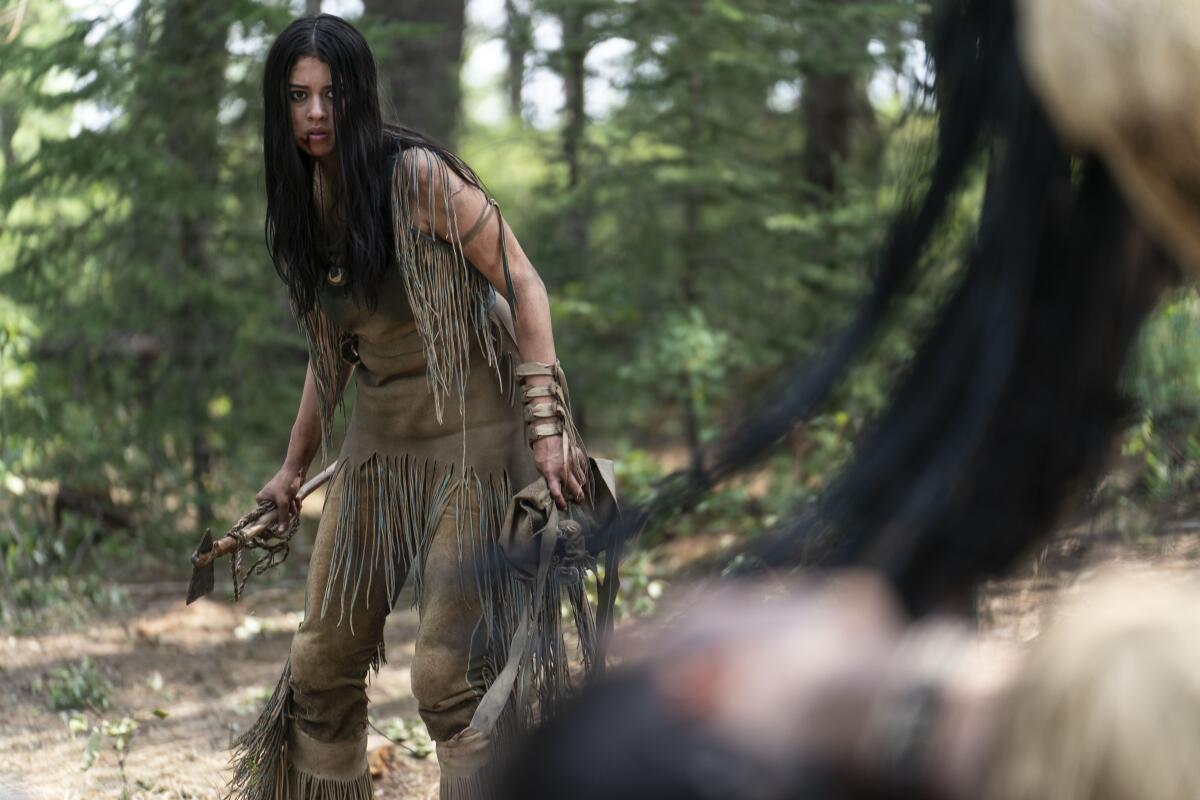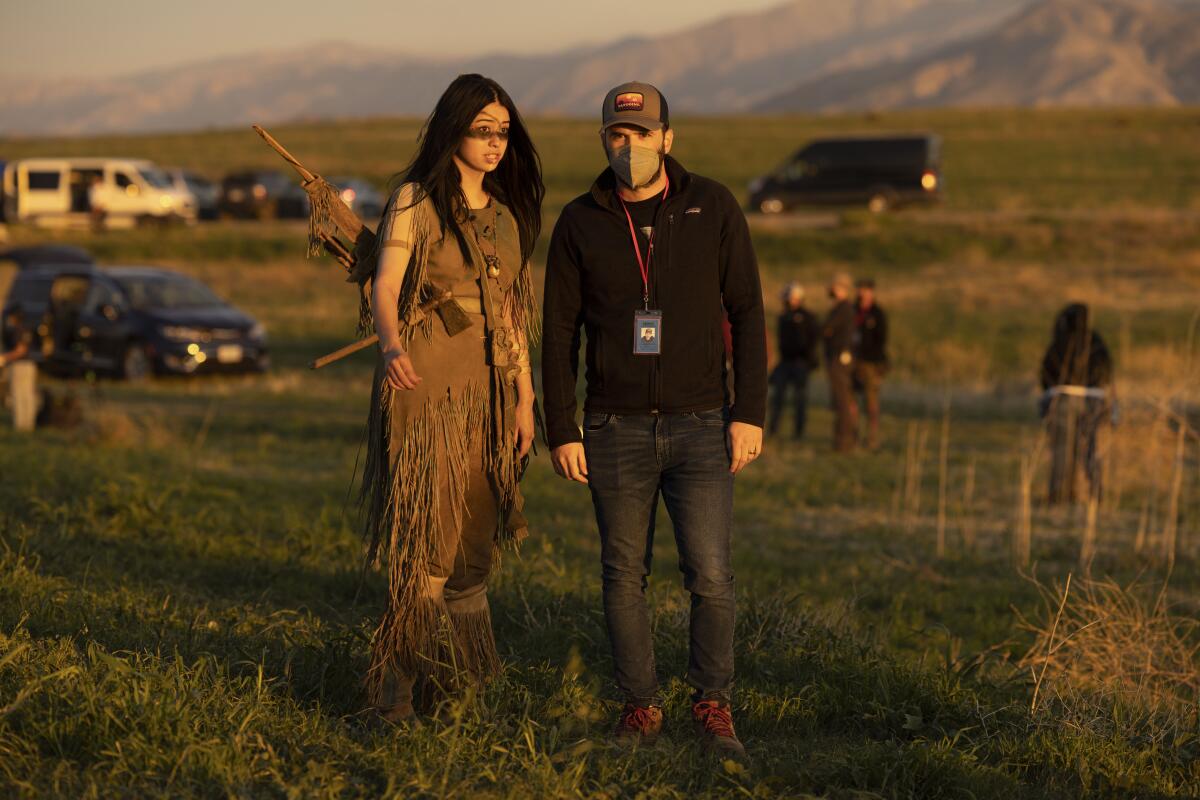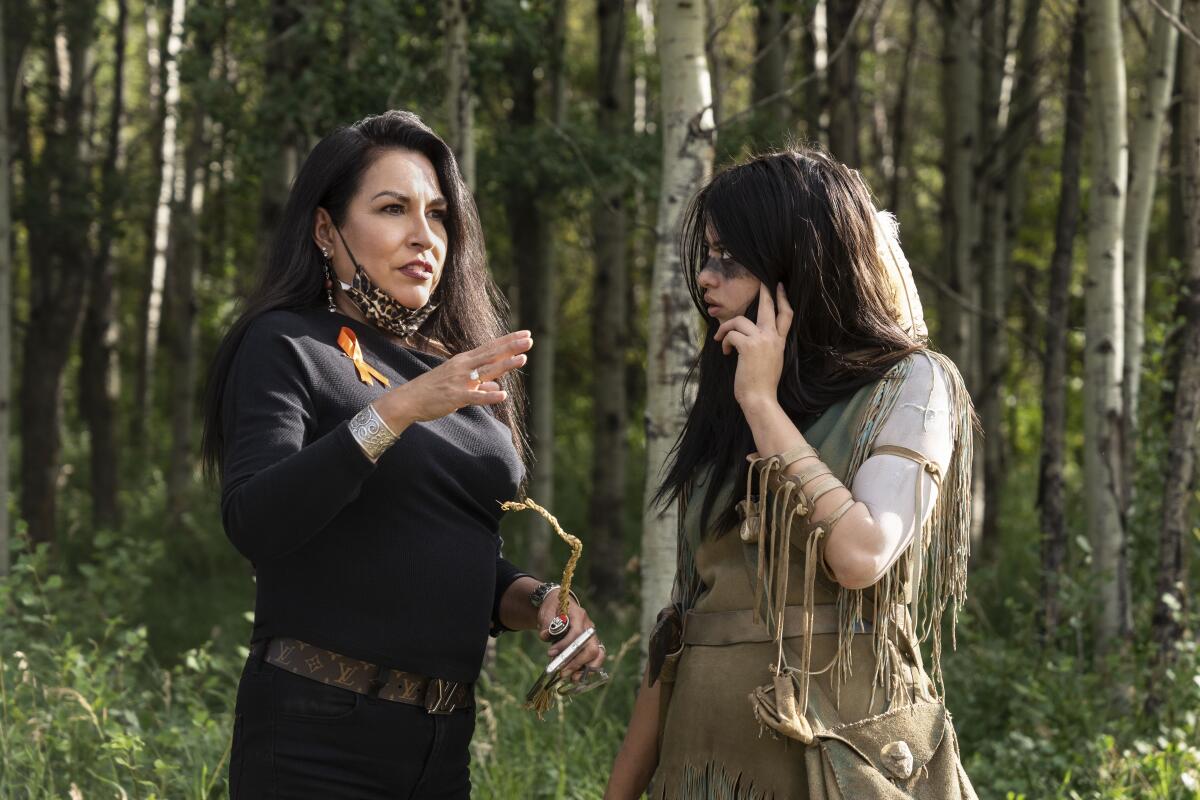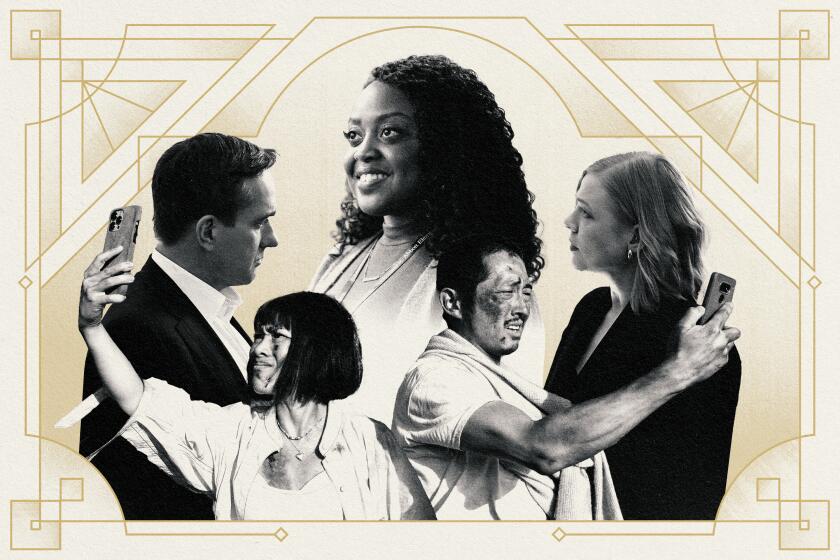Bringing representation to pulse-pounding life, ‘Prey’ is the apex ‘Predator’

- Share via
In an age that has blurred the lines of what television movies even are, it’s fitting that one that feels too cinematic for TV should be nominated for six Emmys. It’s sci-fi but a period piece. It’s about a young woman coming into her own, an atmospheric coming-of-age story — with a space monster in it. It’s a prequel that’s a clear improvement over its predecessors. But rarest: It’s a wide-audience Hollywood movie with an Indigenous cast.
As the Predator found, this “Prey” surprises.
Director and co-writer Dan Trachtenberg (“10 Cloverfield Lane”) says he wanted to tell a story primarily through action but that wasn’t just an action movie. “Could there be a real emotional core that would be as [involving] as the action scenes? So I thought about taking the engine of a sports movie, an underdog story — then we’d be firing on all cylinders. Is there a protagonist we never get to see on-screen, so the underdog story is not just inside the movie; it’s outside as well? And that led me to Native Americans and, more specifically, the Comanche, who so often in American cinema have been relegated to playing the sidekick or the villain.”
Producer Jhane Myers agrees: “For me, being an enrolled Comanche member, that was really important, because of all the years Comanche people have been portrayed as — we kill everything, burn everything, take what we want — that’s all that [moviegoers] ‘knew’ about Comanches. Native Americans are the most underrepresented group. This was one way to re-educate the world and show them who Native people really are.”
Streaming on Hulu, the film, whose nominations include those for TV movie and writing and directing for Trachtenberg, can be played in the Comanche language too.
“This film launched to the world — it was on Hulu, then Disney+ internationally — the world got to hear what Comanche sound like when they speak their language. What are their relationships — to their families, their friends, their culture, to the earth? Nobody has seen us use our medicine,” Myers adds.

“I was excited to see an Indigenous female hero that lives within a period piece, and she is so a whole and real person,” says Amber Midthunder, “Prey’s” now-26-year-old star, before the actors’ strike. One can forgive her for being a little confused when, in a compelling script she was reading about Naru, a Comanche girl in 1719, a clicking, murderous alien showed up. And he’s familiar to most audiences.
“Prey” is part of the well-known “Predator” sci-fi franchise. The 1987 debut film, starring Arnold Schwarzenegger, introduced an alien race known as the Yautja. A typical specimen is around 8 feet tall, sports advanced weaponry and likes long walks in the forest and hunting humans for sport. The Predators have spawned seven movies, including crossing over into the “Alien” franchise.
“I had not seen the ‘Predator’ movies,” Midthunder says with a bit of a bashful smile. “The clicking is where people really understood what it was. I was like, ‘There’s a monster, and it clicks.’ But I thought it was really cool.”
Juggernauts such as ‘Succession,’ ‘Ted Lasso’ and ‘Abbott Elementary’ ruled the Emmy nominations once again. Here’s the full list.
The film has well-staged action and gore, and one particular bit of fan service “Predator” buffs will love (involving a particular pistol). But Trachtenberg makes a point of noting, “We’re making a movie with a Predator as the antagonist, but that’s very different than making ‘a Predator movie.’” “Prey” takes less inspiration from, say, “Alien vs. Predator” than it does “The New World” or “The Thin Red Line” by notably atmospheric auteur Terrence Malick.
“Malick has a very specific sense of cinematography, very wide-angle lens and docu-style ... those were big inspirations in general for me, both musically and visually. I’ve always been drawn to when A directors make B material — ‘B’ for ‘Blockbuster’ — more genre, commercial material,” Trachtenberg says.
“Prey” takes time with its characters, and its environs don’t feel like a set; they feel like a real place where people live.
“We were shooting around Calgary, Alberta; we shot a lot on Stoney Nakoda Reserve land, and I’m not Stoney, but I’m Nakoda,” Midthunder says. “Just thinking about the time period and where we were and how I was dressed — it was really impactful in a way that I did not expect. When we were doing the Comanche camp stuff, seeing everybody in their buckskins and the tepees and everything, but then you would also see, like, a crane — I’m back with my ancestors, then, ‘Ah! Equipment!’ ”

Midthunder says thoughtful representation “was a collective priority. But that can only be fulfilled if your director and producers create that space for you. And definitely that was what we had. Jhane created a binder the first day I showed up — it was this big and filled with facts and pictures and clothes and how people did this and that.
“Dan is the picture of an ally. He was very interested in the realness of everything. ‘How do people brush their teeth? How did the day-to-day things work?’ The simplest things, which seem so small and unimportant — that’s a huge part of humanizing Indigenous people in media.”
Those kind of details inform the film throughout, sometimes in ways outsiders won’t understand. In the nighttime climax, Naru, her tribe’s last line of defense, calls the demon out.
“She whistles, which was not in the script,” Trachtenberg says. “It came from Jhane, because in Southern Plains culture, it’s a big no-no to whistle at night. So every Comanche in the audience, they freak out.”
Myers says, “I’m like, ‘OK, Amber, when you do this line, I want you to whistle.’ She looked at me and said, ‘Oh, my God, I’m not whistling! You, you whistle.’ And I said, ‘No!’ because we both had that same tradition where if you whistle it calls spirits to you. Bad spirits. We tell our kids, ‘Don’t whistle at night.’ It’s like a little Easter egg just for Native people.”
“Amber,” Trachtenberg clarifies with a laugh, “did not whistle. She just mouths it, and our [assistant director] does the whistle.”
Our BuzzMeter panel of veteran TV journalists predicts the winners in 14 categories of the 2023(?) Emmys. You can, too, in our weekly polls.
More to Read
Sign up for The Envelope
Get exclusive awards season news, in-depth interviews and columnist Glenn Whipp’s must-read analysis straight to your inbox.
You may occasionally receive promotional content from the Los Angeles Times.










